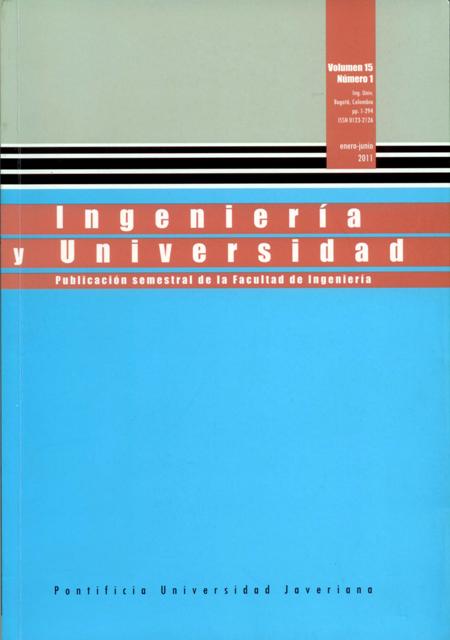Abstract
This work presents a step-by step calculation strategy to solve the equilibrium model applied to an absorption column. The algorithm used manipulates the equations of the column by grouping them into sets for each stage. Each group is treated separately through a flash calculation. This is a generalization of the algorithm for extraction cascades, which now covers two more cases: a) recirculation between stages and, b) the possibility of several feeding modes. Three case studies with specific settings are presented: a) A columna with a partial reboiler and specified heat flow; b) a column with several feeding modes; and c) a column with recirculation between stages
ÁLVAREZ AGUILAR, E. Desarrollo de un algoritmo para la simulación de una columna de absorción para hidrocarburos de C3 a C6 procedentes del gas natural por el modelo de etapas de equilibrio. Bogotá: Universidad de América, Facultad de Ingenierías, 2010.
ASPEN TECHNOLOGY. Aspen Plus [software de simulación]. Cambridge: AspenTech, 2006 [consulta: 17-12-2009].
BAUSA, J. y MARQUARDT, W. Quick and reliable phase stability test in VLLE flash calculations by homotopy continuation. Computers and Chemical Engineering, 2000, vol. 24, núm. 11, pp. 2447-2456.
BOSTON, J. F. y SULLIVAN, S. L. JR. A new class of solution methods for multicomponent, multistage separation processes [documento en línea]. AIChE Journal. 1974, vol. 52, núm. 1, pp. 52-63 [consulta: 15-5-2010].
BOUKOUVALAS, C. J. et al. The performance of Eos/GE models in the prediction of vaporliquid equilibria in asymmetric systems [documento en línea]. Fluid Phase Equilibria. 1996, vol. 116, núms. 1-2, pp. 480-487 [consulta: 10-07-2009].
BURNINGHAM, D. W. y OTTO, F. D. Which computer design for absorbers? Hydrocarbon Processing. 1967, vol. 46, núm. 10, pp. 163-170.
CHANG, C.-H. y ZHAO, X. A new generalized equation for predicting volumes of compressed liquids [documento en línea]. Fluid Phase Equilibria. 1990, vol. 58, núm. 3, pp. 231-238 [consulta: 10-07-2009].
GMEHLING, J.; LI, J. y SCHILLER, M. A modified UNIFAC model 2: Present parameter matrix and results for different thermodynamic properties [documento en línea]. I&EC Research. 1993, vol. 32, núm. 1, pp. 178-193 [consulta: 27-03-2009].
GREEN, D. W.; MALONEY, J. O. y PERRY, R. H. Perry’s chemical engineers handbook. 7th ed. New York: McGraw Hill, 1999.
HENLEY, E. J. y SEADER, J. D. Separation process principles. 2nd ed. New York: John Wiley & Sons, 2006.
HOLLAND, C. D. Fundamentals of multicomponent distillation. New York: McGraw Hill, 1981.
JALALI, F.; SEADER, J. D. y KHALEGI, S. Global solution approaches in equilibrium and stability analysis using homotopy continuation in the complex domain. Computers and Chemical Engineering. 2008, vol. 32, núm. 10, pp. 2333-2345.
KINCAID, D. y CHENEY, W. Numerical analysis, mathematics of scientific computing. 3rd ed. s. l.: American Mathematical Society, 2002.
LIN, W. J.; SEADER, J. D. y WAYBURN, T. L. Computing multiple solutions to systems of interlinked separation columns [documento en línea]. AIChE Journal. 1987, vol. 33, núm. 6, pp. 886-897 [consulta: 01-11-2010].
NAPHTALI, L. M. y SANDHOLM, D. P. Multicomponent separation calculations by linearization [documento en línea]. AIChE Journal. 1971, vol. 17, núm. 1, pp. 148-153 [consulta: 15-5-2010].
O’CONNELL, J. P.; POILING, B. E. y PRAUSNITZ, J. M. The properties of gases and liquids. 5th ed. New York: McGraw Hill, 2001.
PENG, D.-Y. y ROBINSON, D. B. A new two-constant equation of state [documento en línea]. Industrial and Engineering Chemical Fundamentals. 1976, vol. 15, núm. 1, pp. 59-64 [consulta: 15-5-2010].
POLING, B. E.; PRAUSNITZ, J. P. y REID, R. C. The properties of gases and liquids. 4th ed. New York: McGraw Hill, 1987.
SÁNCHEZ, C. A.; ARTURO, J. E. y CÁRDENAS, A. C. Algoritmo etapa a etapa para la simulación de cascadas de extracción en fase líquida aplicando el modelo de equilibrio [documento en línea]. Revista EIA. 2009, vol. 12, pp. 39-58 [consulta: 15-05-2010].
SEYDEL, R. y HLAVACEK, V. Role of continuation in engineering analysis [documento en línea]. Chemical Engineering Science. 1987, vol. 42, núm. 6, pp. 1281-1295 [consulta: 27-03-2009].
STEYER, F.; FLOCKERZI, D. y SUNDMACHER, K. Equilibrium and rate-based approaches to liquid–liquid phase splitting calculations. Computers and Chemical Engineering. 2005, vol. 30, pp. 277-284.
TAYLOR, R. y KRISHNA, R. Multicomponent mass transfer. New York: John Wiley & Sons, 1993.
TREYBAL, R. E. Operaciones de transferencia de masa. 2nd ed. New York: McGraw Hill, 1970.
VICKERY, D. J. y TAYLOR, R. Path-following approaches to the solution of multicomponent, multistage separation process problems [documento en línea]. AIChE Journal. 1986, vol. 32, núm. 4, pp. 547-556 [consulta: 27-03-2009].
WANG, J. C. y HENKE, G. E. Tridiagonal matrix for distillation. Hydrocarbon Processing. 1966, vol. 45, núm. 8, pp. 155-163.
YAMADA, T. y GUNN, R. D. Saturated liquid molar volumes, Rackett equation [documento en línea]. Journal of Chemical and Engineering Data. 1973, vol. 18, núm. 2, pp. 234-236 [consulta: 27-03-2009].
This journal is registered under a Creative Commons Attribution 4.0 International Public License. Thus, this work may be reproduced, distributed, and publicly shared in digital format, as long as the names of the authors and Pontificia Universidad Javeriana are acknowledged. Others are allowed to quote, adapt, transform, auto-archive, republish, and create based on this material, for any purpose (even commercial ones), provided the authorship is duly acknowledged, a link to the original work is provided, and it is specified if changes have been made. Pontificia Universidad Javeriana does not hold the rights of published works and the authors are solely responsible for the contents of their works; they keep the moral, intellectual, privacy, and publicity rights.
Approving the intervention of the work (review, copy-editing, translation, layout) and the following outreach, are granted through an use license and not through an assignment of rights. This means the journal and Pontificia Universidad Javeriana cannot be held responsible for any ethical malpractice by the authors. As a consequence of the protection granted by the use license, the journal is not required to publish recantations or modify information already published, unless the errata stems from the editorial management process. Publishing contents in this journal does not generate royalties for contributors.


